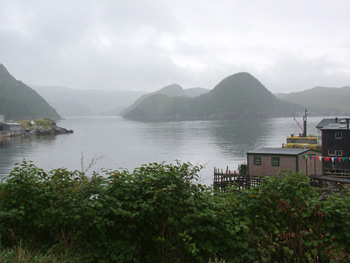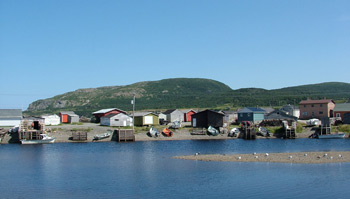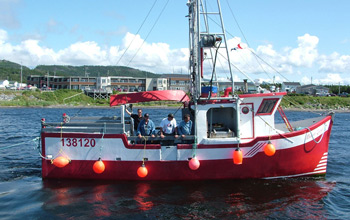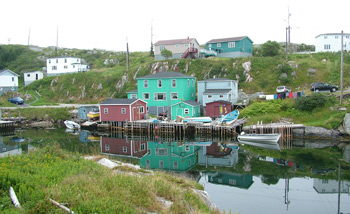Newfoundland
by Mike Crowe

LeCou Harbor, a small fishing village in southwest Newfoundland, 2010. The fishing moratorium has changed fishing, some think not enough. It has changed the population and character of some towns. Fishermen’s Voice Photo
Like New England, Newfoundland is under severe groundfish quota cuts that are leaving many small-boat groundfishermen on the edge of survival. Unlike New England, Newfoundland has had a groundfish moratorium since the cod fishery collapsed in 1992.
The moratorium has not resulted in the stocks rebounding in the eyes of Canadian regulators. Fishermen have gained access to small amounts of quota. Most fish several fisheries to put together a modest income in the industry.
The small number of boats today in once thriving harbors is a pretty good indication of the viability of making a living from fishing in what not long ago were the richest fishing grounds in the world.
The country (it was an independent country before joining Canada as a province in 1949) was established as a fishing outpost 100 years before the Pilgrims set sail for Plymouth.
Not long after John Cabot, exploring and mapping Newfoundland for the English king in 1497, Basque fishermen set up a fishing station at Red Bay, Labrador.
Sailing from their home ports between southern France and northern Spain, they established formal fishing stations. It is believed Basque fishermen visited Newfoundland waters to fish long before Cabot. He may, in fact, have had information from Basque fishermen that this place was actually out there.
One of those stations was at Red Bay Labrador, located 25 miles across a strait at the northernmost tip of Newfoundland.
By 1550, Red Bay was the whale hunting capital of the world. Basque fishermen hunted whales there from small vessels.

Trout River, Newfoundland much the way it has been through it's long history as a fishing village. Fishermen’s Voice Photo
Five hundred years before Cabot, the Vikings established a settlement on the northeast tip of Newfoundland at L’anse aux Meadows. The Vikings built turf-roofed long houses, saunas, and a fortress of sorts. Newfoundland had been inhabited, and still is, by natives who have lived there for thousands of years.
Newfoundland has been known around the world as a fishing industry state. Nature built it that way. The nearby Grand Banks were an ideal and densely populated place for cod to spawn and grow.
By the time humans started fishing cod, the cod’s self-sustaining system was well established. A few thousand years of native fishing was more like a culling process than an impact of any kind. Even a few hundred years of European and later American fishing from larger sailing vessels in much greater numbers were sustainable. Today, with the moratorium in place, fishermen with a small amount of quota are back to using what their ancestors, native and European, used to catch cod- hook and line.
Newfoundland fishermen said they were aware that for years larger industrial vessels and technologically-equipped smaller vessels, were able to take large quantities fish of all ages and types. Heavy equipment beat up the habitat where cod spawned and grew in those years.
But, we didn’t know it at the time, said Roger Shears of Rocky Harbor. At the time, smaller vessel operators objected to the big industrial ships, because their catch rates began going down as the number of large vessels increased. However, the bigger picture of what was happening was not clear to them. This was all in the context of a long-held fishing standard where you fished as long and hard as necessary to fill the boat.
Shears fishes the Robert’s Quest out of Rocky Harbor on the west coast of Newfoundland. Roger is a lifelong fisherman from a family whose ancestors were fishermen as far back as anyone can calculate. He is also the last member on both sides of his family who is still fishing. He built the 40’ Robert’s Quest in the yard of his home in Rocky Harbor.
Since the 1992 moratorium, fishing effort has come to be measured in hours in some cases. “We used to fish as hard and long as we could. Back then we fished cod traps and caught 10,000 pounds with on of them. The cod traps were 90 feet to 120 feet in diameter and 20 feet high. They were net-walled and hauled by hand with a crew of four. But they are banned.
“Now we can either use 6 gill nets or 2,000 hooks. The quota is 3,000 pounds a week. But we don’t catch the quota,” said Roger. “There’s plenty of halibut, but we have just 36 hours a year to fish halibut. That’s 36 hours from the time we set the gear until we pull it out. That includes about 6 hours or more of steaming.”
“Gill-netting produces a low quality product. At 50 cents a pound for cod you can’t keep a crew. We prefer hooks, but it has little effect on price at the local fish plant,” he said.
Most fishermen here have to fish several fisheries to get by. They belong to a union that Roger says, “does nothing for us. We are required to belong to the union and pay the dues.” If a fishermen’s dues are not up to date he can be fined and his catch seized.

The 40' Robert's Quest heading out of Rocky Harbor, Newfoundland to haul trawl lines. They are allowed 2,000 hooks, with a 3,000 lb. cod quota they never make. There were 50 commercial fishing boats in Rocky Harbor when Captain Roger Shears, far right, started fishing 30 years ago, today there are 10. Fishermen’s Voice Photo
The lobster season is down to 10 weeks between April and June. But the catch has not been good, and the prices no better according to fishermen on the west coast.
South of Rocky Harbor at Trout River the story was not much different. The port looked as it probably has for many decades. In fact, it looks like a lot of Maine ports did a few decades ago. The inlet is lined with fish houses where fishermen store their gear, clean fish and keep a base of operations for their businesses. The village is clearly centered around fishing. The short streets are mostly unpaved, the homes modest, and the atmosphere quiet. There is a fish processing plant in the harbor.
Malcom Butler and Henry Parsons had just returned from a trip tub-trawling for cod from their open boat powered by an 80 HP Yanmar. They spoke to the Fishermen’s Voice about fishing conditions in Trout River. Like most coastal towns here the 1992 moratorium has hit hard.
There were about 50 boats fishing out of Trout River before the moratorium, today there are 25 commercial boats. These two guys lobster fish as well, but this year and last the fishing has not been good. The crab season here has been closed for twp years, and it may remain closed for another two years, said Butler.
Most lobstermen fish wooden traps here. There is a 300-trap limit in a 10-week season. The carapace length is 3 1/4". They use the V notch, there is no quota, and the boat price has been $3 to $3.20. “The same as 30 years ago,” said Butler.
Butler and Parsons did not have much good news to report. “Caplin was not in this year for the first time in 50 years. There are 80’ boats offshore taking them and caplin are not coming inshore,” said Butler.
Gilbert Crocker of Trout River had a more optimistic view of things. He said this year is down, but overall the catch has been pretty good. He’s been fishing at Trout River since he was 15. He fishes out of a 17’ traditional flat bottom wooden dory, and has for the last 35 years. Crocker will sometimes go out 10 miles to set hooks. He also fishes 250 wood lobster traps out of that dory.
Of the moratorium, he said things have been the same since it started, but they should have shut the fishery down altogether in 1992. Some fishermen with small quotas have been fishing all along. Fishermen could have been given unemployment insurance he said. They get it now when the fishery closes for the winter.
About 30 miles east of Port Aux Basques at the southwestern tip of the province is the village of Harbour LeCou. This picturesque fishing village, with fish houses and homes clinging to the rocky shore and mountainous islands in the harbor, is no longer an attractive place for fishermen.
Retired LeCou fisherman Bill Buckland talked of fishing back in the day. Those days, which lasted 400 years, came to a relative screeching halt in 1992. The tradition of sons of fishermen who were sons of fishermen down through the generations is being lost before the eyes of those whose lives have bridged a Newfoundland with many opportunities from the sea to one with very few. What’s more, a Newfoundland with few opportunities of any kind to replace those lost.

Village of Rose Blanche at the end of the road east of Port aux Basques, Newfoundland. Once a thriving fishing village the groundfish plant here closed years ago. Efforts to boost tourism have not produced very significant results. Kayla Crowe Photo
Tourism has been offered as a government-induced replacement. In nearly every coastal village and town in Newfoundland the roots of a fishing heritage are apparent. It is impossible to underestimate what the fishing industry has meant to Newfoundland.
Bill Buckland’s neighbor mentioned that the village now had some tourists and a few summer residents, but with a fairly cool, often foggy, and frequently rainy summer climate it is difficult to see how tourism will make a dent in Newfoundland’s struggling coastal economy.
Roger Shears back in Rocky Harbor said the “government wants to drive the small fishermen out of the industry. They are more interested in giving the resource to the large offshore boat fleet. They say they are interested in rebuilding the fisheries, but that is not what they’ve done in the last 17 years.”
Just beyond LeCou, is the village of Rose Blanche. A large village with houses perched on the rocks at the water’s edge or on stilts half over the water. Narrow one-lane roads wind around the cliffside neighborhoods. One of those roads leads to the abandoned, rusted-out hulk of the fish processing plant. The deepwater wharves are still in place, but not even the seagulls come here now.
Most of the Newfoundland fishermen interviewed eventually got around to their assessment of what has caused Newfoundland’s fisheries woes. The fisheries are said to be negatively effected by any number of proven and unproven or quantifiable impacts in recent decades—water temperatures, ocean acidification, chemical runoff, ocean dumping, melting ice caps, etc.
But the single most identifiable impact that marked the shift in the sustainability of their resource, they said, has been industrialized fishing. Fishing had been getting more industrialized for 50 years by the 1970s. But most notably it was the factory ships, freezer ships, and enormous trawlers that showed up in the 1970s.
By the early 1990s it was evident that the resource could not stand up to that kind of effort. What mystifies fishermen is how the government says on the one hand they are reducing quotas to traditional fishermen in order to rebuild the resource, while at the same time keeping high impact big boats on the water.
As tough as things are here economically, Newfoundland’s musical traditions are alive and well. Practically everywhere you go the there is a performance about to go on, running into musicians playing is nearly unavoidable, it seems everyone is willing get up to sing something.
